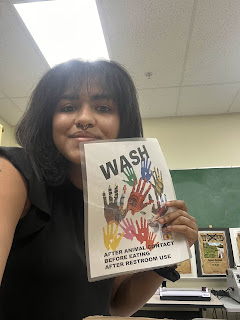Bridget Duffy

The residency tour was really interesting because even though I go to University of Maryland, I saw programs I had never even heard of before. The microbiology lab that we did, testing for E.coli in a stream was one of my favorite activities. I have always enjoyed biology and lab work coming from an environmental perspective, and I got to learn a new technique. I had only heard about E.coli from the outbreaks that were talked about on the news so I had always assumed it was very harmful. But I learned that most varieties cause little to no harm, it just signifies a presence of fecal matter. That said it was also unfortunate to see just how much E.coli was living in the water we were watching kids splash around in only minutes beforehand. (Setting up agar plates with sediment from the stream we were testing.) Another part that I loved was when we went to the bug zoo. I had heard about that being on campus but this was the first time I ever got to see it. I have always been a bug lo...

.png)



.JPG)



